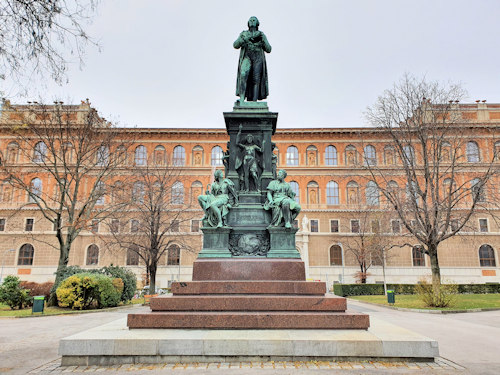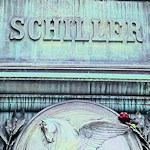Not every statue in Vienna honours a famous local. The Schiller monument, for example, commemorates the legacy of one of the great German playwrights and poets.
- A bronze Schiller stands atop allegorical reliefs and statues
- Unveiled in 1876
- Central park location features other literary monuments
- Browse and book a guided tour* for Vienna
- See also:
Statues, reliefs and allegories

(The building behind the monument is the Academy of Fine Arts Vienna)
The writer Friedrich Schiller (1759–1805) may not have lived or worked in Vienna, but he left an indelible mark on German and European literature.
Schiller also inspired various composers with a strong Viennese connection to put his words to music. Schubert and Brahms, for example. Or Beethoven in his Ninth Symphony, which famously draws on Schiller’s Ode to Joy.
Vienna’s monument to this literary genius dominates a small central park that appeared in the late 1870s as part of the huge redevelopments that followed the removal of the old city fortifications.

(The park and square)
The appropriately-named Schillerpark exudes literary talent, since it includes smaller monuments to the likes of the poet Nikolaus Lenau (1802-1850) and the writer Franz Werfel (1890-1945).
Efforts to erect a monument to Schiller’s genius began in 1868 through a private initiative. The unveiling took place on November 10th, 1876 on the anniversary of Schiller’s birthday.

(Crowds attend the unveiling; Smeeton & Tilly (xylographer), 1877, Wien Museum Inv.-Nr. W 5816, reproduced with permission under the terms of the CC0 licence)
Other events commemorated “Schiller’s day” that year. The Burgtheater, for example, put on performances of his first and last efforts as a playwright: The Robbers and Demetrius (unfinished).
The monument design by Johannes Schilling has granite steps below various bronze figures and reliefs. Schiller stands at the top.
- The four corner statues represent stages of life: a mother with baby, a youth, a man, and an old man.
- The four figures in relief represent (if I’m translating original news reports correctly) poetry, genius, wisdom, and charity/kindness. I’ve seen the last two allegories also described as science and love of your country.
- The four circular reliefs show (ditto regarding my translation) a pelican with its chicks, the head of Minerva, Pegasus, and a man wearing a Greek (?) tragedy mask, which I assume match the allegorical reliefs.

(The Pegasus relief and other elements)
Incidentally, the imposing 1877 building behind Schiller is the Academy of Fine Arts Vienna.
The paintings gallery inside draws on a rather impressive collection of old masters that includes such names as Titian, Rembrandt, Boticelli, Rubens, and van Dyck. The collection highlight is perhaps the Hieronymus Bosch triptych, The Last Judgment.
The special exhibitions held in the academy are open to the public, but the contents vary and usually also feature contemporary works in dialogue with the older art.
How to get to Schiller
The small park sits opposite the Burggarten on the other side of the great Ringstrasse boulevard. Follow Schiller’s line of sight to see a monument to his friend and another master of the German language: Goethe.
Subway: a short walk west from Karlsplatz station (on the U1, U2, and U4 lines)
Tram/bus: the nearest tram stop is Burgring (on the 1, 2, D, and 71 lines). The 57A bus also passes nearby (get off at Getreidemarkt)
Address: Schillerplatz, 1010 Vienna
